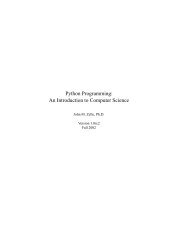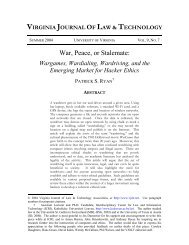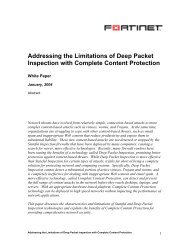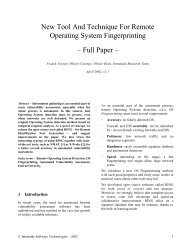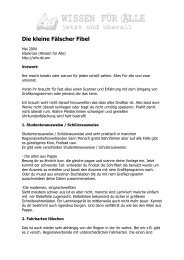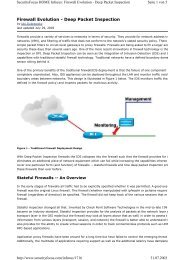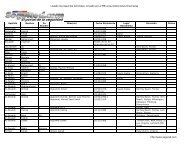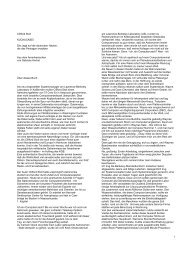EtherLeak: Ethernet Frame Padding Information ... - Leet Upload
EtherLeak: Ethernet Frame Padding Information ... - Leet Upload
EtherLeak: Ethernet Frame Padding Information ... - Leet Upload
Create successful ePaper yourself
Turn your PDF publications into a flip-book with our unique Google optimized e-Paper software.
4<br />
2.0 A Brief Introduction to <strong>Ethernet</strong><br />
This section provides a brief introduction to <strong>Ethernet</strong>, outlining the protocol’s history,<br />
the data transmission structures and how they interface with higher layer protocols.<br />
2.1 History<br />
<strong>Ethernet</strong> was first developed at Xerox labs in Palo Alto, California, in 1973. Seven years<br />
later the DEC-Intel-Xerox (DIX) consortium, formed to standardize and commercialize<br />
<strong>Ethernet</strong> technology, published the first 10Mbps <strong>Ethernet</strong> standard. This standard is<br />
commonly referred so as “<strong>Ethernet</strong> version I”, and a revision of the standard, published<br />
in 1982, is referred to as “<strong>Ethernet</strong> version II”. This last version of the standard is<br />
frequently referred to as the “DIX <strong>Ethernet</strong> Standard”. In 1985 the IEEE published<br />
“Carrier Sense Multiple Access with Collision Detection Access Method and Physical<br />
Layer Specifications”, better known as the 802.3 CSMA/CD standard. Based on the DIX<br />
<strong>Ethernet</strong> standard the IEEE 802.3 standard is currently the official <strong>Ethernet</strong> standard.<br />
Although adding a number of technical changes, the 802.3 standard remains backward<br />
compatible with the original DIX <strong>Ethernet</strong> standard. Since publishing 802.3 the IEEE<br />
has standardized a number of <strong>Ethernet</strong> related technologies such as 100Mbps Fast<br />
<strong>Ethernet</strong>, Gigabit <strong>Ethernet</strong> and others.<br />
2.2 <strong>Ethernet</strong> <strong>Frame</strong>s<br />
<strong>Ethernet</strong> is a link layer protocol used to transmit higher layer protocols between hosts.<br />
Data transition across the <strong>Ethernet</strong> is formed of discrete streams of bits, called frames.<br />
These frames must conform to one of two formats defined within the 802.3 standard.<br />
<strong>Frame</strong> formats enable a receiving system to correctly interpret a bit stream from the<br />
<strong>Ethernet</strong> as intelligible data organized into sections, called fields. Despite technical<br />
differences between the two formats they share several common fields. These fields<br />
provide some protection against data loss, detail the origin and destination of the frame,<br />
contain the encapsulated data and provide other important information.<br />
The data field is a variable length buffer that contains the encapsulated higher-layer<br />
packet being transmitted by the frame over the <strong>Ethernet</strong>. Restrictions within the<br />
<strong>Ethernet</strong> standards limit the size of this field to a minimum of 46 bytes and a maximum<br />
of 1500 bytes. If the higher level protocol data is less than the minimum it must be<br />
padded to the correct size.<br />
The two frame formats differ primarily in the mechanism they use to describe their<br />
encapsulated data, which gives rise to their names “Type encapsulation” and “Length<br />
encapsulation”. The Type encapsulation format describes the contents of its data field by<br />
the type of the higher layer protocol packet it encapsulates. The Length encapsulation<br />
format describes the length of the data field, and uses an optional LLC header to<br />
describe the higher layer protocol type.<br />
<strong>EtherLeak</strong>: <strong>Ethernet</strong> frame padding information leakage<br />
Copyright © 2003, @stake Inc. All Rights Reserved.




